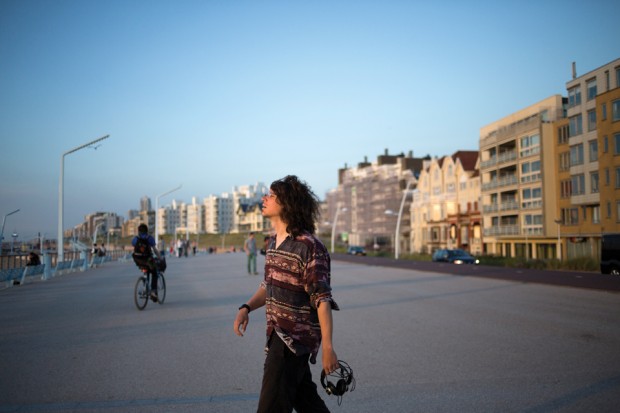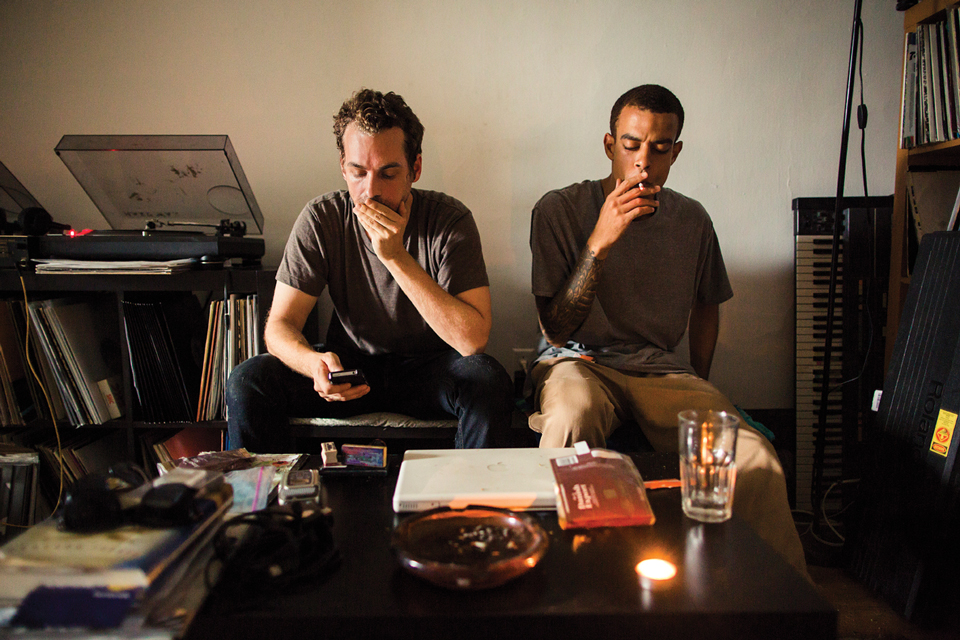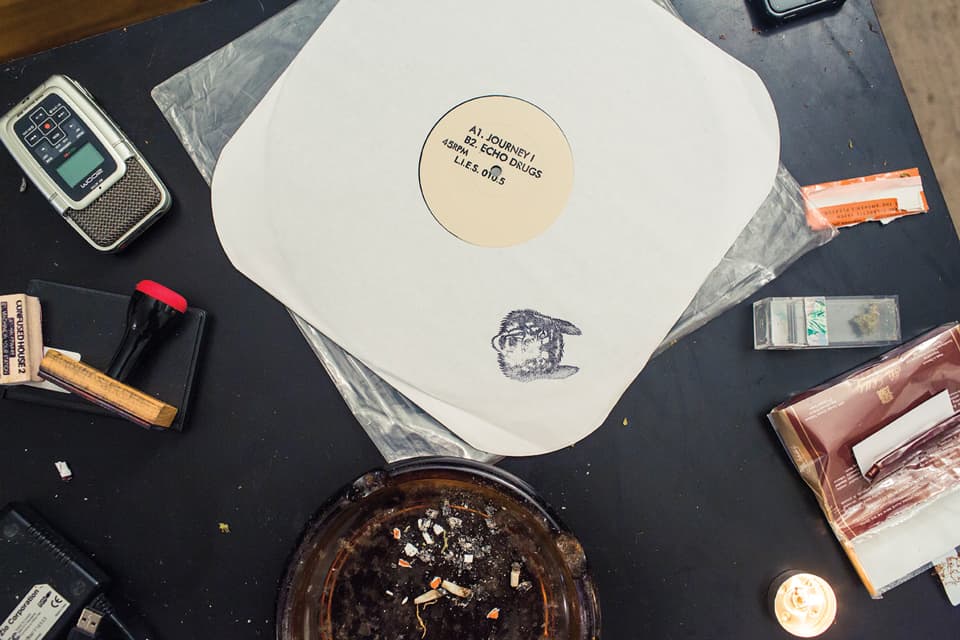Ron Morelli’s L.I.E.S. takes dance music and runs it over with a truck
From the magazine: ISSUE 87, August/September 2013
For more on L.I.E.S., read an oral history of the label.
It’s a little past noon on a Thursday in June, and Ron Morelli needs to send a few emails before he can sit down for a talk. We’re in the sunny Greenpoint apartment that he shares with techno producer Marcos Cabral, and Morelli has a lot to get done before he moves out at the end of August. A handsome, 37-year-old South Shore, Long Island native with big, round brown eyes and a backwards baseball cap, Morelli has been living in the neighborhood for 14 years, and has spent the last four running the label Long Island Electrical Systems (or L.I.E.S.) out of the makeshift office space and recording studio off the kitchen. Lately, he’s been on the road DJing for so many months out of the year that he doesn’t see the point in keeping a place, and like many of the artists and musicians who took up residence in north Brooklyn long before clubs with bouncers and long lines started cropping up along the Williamsburg waterfront, he’s starting to feel like a stranger in his own city. “You know, growing up, if you saw some kid with a Thrasher shirt or a Misfits shirt, then you would go talk to them, because you’re like, Oh, this person’s probably into what I’m into,” says Morelli, his New York accent not far off from a character in a ’70s Scorsese movie. “That doesn’t exist anymore. There’s no counterculture here in New York. There’s nothing to go against—there’s just little pockets of people doing what they do.”
For his part, Morelli has spent most of his life listening to, making, collecting, spinning, researching and talking about records. His massive collection of vinyl, which he’s currently in the process of moving into storage, occupies pretty much every available resting spot in the apartment, including several ceiling-high shelves, half of the floor in the main room and the living room couch, which is pulled up next to a Juno-106 synthesizer on the coffee table. He acquired the bulk of it over four years working at the East Village mainstay A-1 Records, and like the tattoos that run up his arms, it’s the accumulation of a life spent mining the numerous musical fixations that have come and gone in and around the city over the past quarter century, from the skate and punk scenes of his suburban adolescence to the rave scene of the late ’90s, when he first got hooked on the mechanical pulses and synthetic textures that people think of when they think of L.I.E.S.

Several dozen releases in, most of the records in L.I.E.S.’ catalog look pretty much identical—colored labels and plain white sleeves, distinguished only by artist name, song title and the starkly iconic L.I.E.S. logo, its perspectival block letters inspired by a reggae cover. There’s a minor stylistic flourish in the form of a silhouetted map of Long Island, but for the most part, the records present themselves with the sort of functional simplicity that ensures that you might not notice them unless you’re directly seeking them out. These days, though, they sell out almost immediately via internet mail order, mostly to Europe, where Morelli says that people have a “different ear, maybe a little bit more of an interest in things that are slightly off the beaten path.”
Some of the artists on the label’s roster—like New York multi-instrumentalist and film composer Steve Moore, and Holland-based producer Legowelt—were already pretty big names in their respective worlds before they released records on L.I.E.S. But the label also has a sturdy stable of previously little-known beatsmiths whose tireless home recording has found a match with Morelli’s knack for rapidly cranking out releases. Most of them are Brooklyn-based, but a map of the L.I.E.S. community would extend as far west as Los Angeles (Delroy Edwards), as far south as Miami (Greg Beato), and as far east as Paris (Svengalisghost), The Hague (the couple Legowelt and Xosar) and Wiesbaden, Germany (Florian Kupfer). Many of the label’s artists, like Bushwick musician Matt Gardner, who produces scuffed-up, melodic house under the alias Terekke, had never found a home for their music before L.I.E.S. Almost all of them report being surprised by the particular material in their repertoire that Morelli seemed to be jazzed on. “A lot of the peo-ple on the label are doing live techno, live synthesizer music, and that feeling comes out on the records,” says Matt Morandi, aka Brooklyn-based L.I.E.S. artist Jahiliyya Fields. “It sounds less like a painting that someone would make at home, where they’re constructing a track over several months and tweaking all these little things, and it sounds more like something that happens in real time.”

“The way this label came about is just through years of DJing and being friends with people in music,” says Morelli. “Twelve, 13 years of hanging out. And that’s how really interesting stuff happens—it’s not by like sending an email to some random guy in the middle of nowhere who already has records on a different label and you’re being like, Oh, his records are cool and they sell—I should do something.”
Morelli doesn’t seem to like being put in the spotlight, which may be why he has suggested that we spend the day having a group chat at the home of video artist and L.I.E.S. musician Luke Wyatt. On our way out of the apartment, he receives a call from his friend Bill Kouligas, the founder of experimental music label PAN, which is hosting a festival at various venues and art spaces throughout the city this month. One of Kouligas’ artists is desperately in need of a Korg Electribe SX for a performance that evening, and Kouligas is wondering if Morelli knows someone in the L.I.E.S. network with one. Walking up Manhattan Avenue, the sun beating down on the concrete, Morelli calls down his list of contacts, trying to track down the synthesizer.


It’s nearly 2:30PM when we arrive on the fourth floor of an industrial loft building in the Hasidic territory between East Williamsburg and Bushwick, and Luke Wyatt is sitting at the head of the dining room table, devouring a late breakfast of steak and eggs. There is a pair of metal barbells on the floor, and Wyatt, who has recorded as Torn Hawk and done numerous videos for L.I.E.S., has the kind of thrift store style sensibility, hyper-masculine musculature and sharp-jawed good looks that make comparisons to action heroes and adult movie stars somewhat inevitable. A born raconteur, he starts telling a story about how he recently got ditched by two attractive “Russian chicks” who invited him out to trendy Manhattan club Le Baron, but the story ends up being a complicated metaphor for how the underground music scene has become infiltrated by people who are just in it for the hip factor (“When these rich girls left me on the fucking curb it was another example of this—it’s another way of the cool kids in high school keeping you out of the fucking prom”). He’s also eager to refute the popular misconception that L.I.E.S. originated out of some lo-fi dance music trend. “The textures are organic and the footprint of the maker is present, but it doesn’t feel like it’s a pose or somebody’s trying to distress it after the fact,” he says. “The sounds are inseparable from the music and the sound qualities of a piece with the actual composition.” Morelli, sensing that this distressed quality can’t possibly ring true for all the releases he’s put out thus far, points out that the Jahiliyya Fields and Steve Moore records are “clean as fuck” (relatively speaking—both artists fit right in on a 2012 L.I.E.S. compilation titled American Noise).
There are dishes of potato chips and cheese puffs set out on the living room table, and everyone takes turns trying on a blue New York Mets cap that’s in the shape of a cowboy hat. Morelli keeps making phone calls, and for the most part, it’s hard keeping the conversation—loosely about the many half-remembered party nights that brought together the artists on the L.I.E.S. roster—on track. “It’s like people who know each other through natural circumstances, people that actually like each other and respect each other,” says Wyatt of the global community of bedroom recorders and mutant club music obsessives that Morelli has helped bring to people’s attention. “People that enjoy each other’s sensibility. It’s like complimentary world views.” I ask what sort of complimentary worldviews the three of them would say they share. “Feed the starving children,” says Morelli. “The fucking Mets,” says Wyatt. The afternoon dead-ends in a tumble of bathroom jokes and empty beer cans, and Morelli finally gets ahold of someone with an Electribe.

Daniel floats away in the direction of Cabral, and returns a few minutes later, having forgotten about the introduction. “That guy is so amazing,” he says, referring to Cabral. I ask Daniel what he’s been up to since we last saw each other, and he says he’s mostly just been trying to get his ducks in a row before rolling out this new label he’s starting. He tells me the name of the artist whose record he is planning on releasing, and I ask him what the music sounds like. “Oh, you know, he’s just another one of those totally unknown but insanely prolific dance music dudes.” I glance up at Morelli, and think of the hundreds of amazing songs that the world would never hear if he hadn’t started L.I.E.S. Then I look down at the dance floor, and contrary to the club’s reputation for attracting a well-heeled Manhattan clientele, it’s pretty much all the usual faces that you’d expect to see at a L.I.E.S. show in Brooklyn. Morelli’s set has spiraled into contrapuntal insanity, and suddenly I notice that everyone is dancing.
1. Ron Morelli in Brooklyn, NY.
2. Legowelt (Danny Wolfers) and Xosar (Sheela Rahman) in The Hague, NL.
3. Xosar at home in The Hague, NL.
4. Legowelt in The Hague, NL.
5. Steve Summers and Bookworms (Nik Dawson) at home in Brooklyn, NY.
